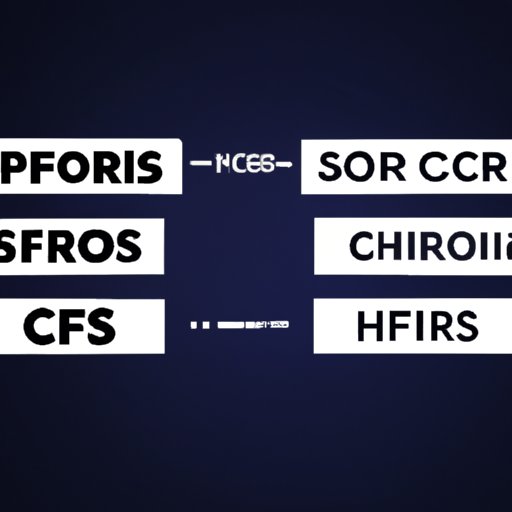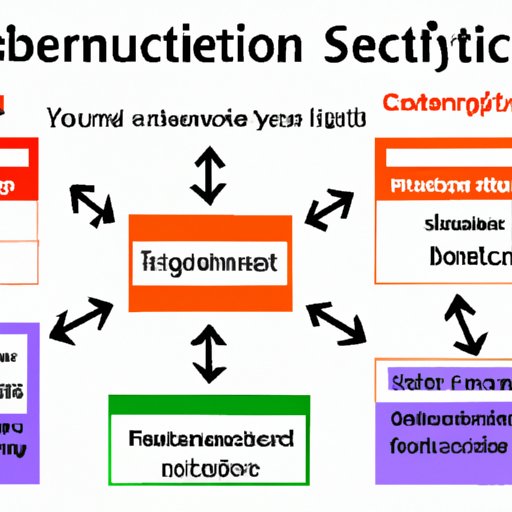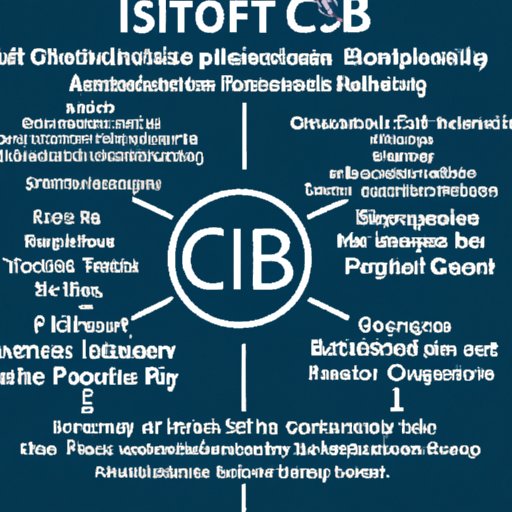Introduction
Cybersecurity is an ever-evolving field that is becoming increasingly important in today’s digital age. With the rise of cybercrime and the growing sophistication of cyberthreats, it is essential for businesses to have robust security measures in place to protect their data, networks, and systems. One way to do this is by implementing a cybersecurity framework, which is a set of guidelines and best practices designed to help organizations manage and reduce their risk of cyberattacks.
In this article, we will explore what the best cybersecurity framework is for businesses. We will compare popular cybersecurity frameworks, explain their pros and cons, and provide a comprehensive guide to help you choose the right framework for your business.
Comparing Popular Cybersecurity Frameworks: Which is Best for Your Business?
When it comes to choosing the best cybersecurity framework for your business, there are many options to consider. Each framework has its own unique set of features and benefits, and the one that is best for your organization will depend on your specific needs and requirements.
Some of the most popular cybersecurity frameworks include the National Institute of Standards and Technology (NIST) Cybersecurity Framework, the International Organization for Standardization (ISO) 27001, the Information Security Forum (ISF) Standard of Good Practice, and Control Objectives for Information and Related Technologies (COBIT) 5. Let’s take a look at each of these frameworks in more detail.

A Comprehensive Guide to the Top Cybersecurity Frameworks and Their Benefits
NIST Cybersecurity Framework
The NIST Cybersecurity Framework is a comprehensive set of guidelines and best practices developed by the U.S. Department of Commerce’s National Institute of Standards and Technology (NIST). It is designed to help organizations identify, assess, and manage cybersecurity risks in order to protect their systems and data. The framework includes five core functions – Identify, Protect, Detect, Respond, and Recover – and provides guidance on how organizations can use these functions to create an effective cybersecurity program.
ISO 27001
ISO 27001 is an international standard published by the International Organization for Standardization (ISO). It outlines a comprehensive set of requirements for establishing, implementing, maintaining, and improving an information security management system (ISMS). The standard provides a framework for organizations to identify, assess, and manage their information security risks in order to protect their systems and data.
ISF Standard of Good Practice
The Information Security Forum (ISF) Standard of Good Practice is a collection of best practices and guidelines for managing information security risks. The standard covers topics such as security strategy and governance, risk management, data protection, access control, incident response, and compliance. It is designed to help organizations identify, assess, and manage their cybersecurity risks in order to protect their systems and data.
COBIT 5
COBIT 5 is a framework developed by the Information Systems Audit and Control Association (ISACA). It is designed to help organizations identify, assess, and manage their IT-related risks in order to protect their systems and data. The framework includes four domains – Governance, Acquisition & Implementation, Delivery & Support, and Monitoring & Evaluation – and provides guidance on how organizations can use these domains to create an effective IT governance program.
Other Popular Cybersecurity Frameworks
In addition to the frameworks mentioned above, there are other popular cybersecurity frameworks that organizations may want to consider. These include the Payment Card Industry Data Security Standard (PCI DSS), the Federal Information Security Management Act (FISMA), and the Health Insurance Portability and Accountability Act (HIPAA). Each of these frameworks has its own set of requirements and guidelines for protecting sensitive information.

Exploring the Pros and Cons of Different Cybersecurity Frameworks
Pros of NIST Cybersecurity Framework
- Provides guidance on how to identify, assess, and manage cybersecurity risks.
- Includes five core functions and provides clear steps on how to implement them.
- Is widely accepted and regularly updated.
Pros of ISO 27001
- Provides guidance on how to establish, implement, maintain, and improve an information security management system.
- Includes detailed requirements for each stage of the information security lifecycle.
- Is recognized internationally.
Pros of ISF Standard of Good Practice
- Provides guidance on how to identify, assess, and manage information security risks.
- Covers a wide range of topics related to information security.
- Is regularly updated to reflect the latest threats and technologies.
Pros of COBIT 5
- Provides guidance on how to manage IT-related risks.
- Includes four domains and provides clear steps on how to implement them.
- Is widely accepted and regularly updated.
Cons of Different Cybersecurity Frameworks
While all of these frameworks offer benefits, they also have some drawbacks. For example, they can be complex and difficult to understand, require significant resources to implement, and may be outdated or incomplete. Additionally, some of them are not applicable to certain organizations or industries.

How to Choose the Right Cybersecurity Framework for Your Company
Choosing the right cybersecurity framework for your company can be a daunting task. To make sure you select the best option for your organization, here are some tips to keep in mind:
Assessing Your Company’s Needs
The first step is to assess your company’s needs. This means evaluating your current security posture, identifying potential risks and vulnerabilities, and understanding the types of data and systems you need to protect. Once you have a clear understanding of your company’s needs, you can begin evaluating the different frameworks.
Evaluate the Different Cybersecurity Frameworks
Once you’ve identified your company’s needs, you can start comparing the different frameworks. Look at each framework’s features, benefits, and costs to determine which one is the best fit for your organization. Consider factors such as scalability, ease of use, and security measures.
Select the Framework That Best Meets Your Needs
After evaluating the different frameworks, select the one that best meets your needs. Make sure you understand the framework’s requirements and have a plan in place to implement it. You should also ensure that you have the necessary resources to maintain the framework over time.
An Overview of the Most Common Cybersecurity Frameworks
Now that you know how to choose the right cybersecurity framework for your company, let’s take a look at the most common frameworks. Here is a brief overview of each one:
NIST Cybersecurity Framework
The NIST Cybersecurity Framework is a comprehensive set of guidelines and best practices developed by the U.S. Department of Commerce’s National Institute of Standards and Technology (NIST). It is designed to help organizations identify, assess, and manage cybersecurity risks in order to protect their systems and data.
ISO 27001
ISO 27001 is an international standard published by the International Organization for Standardization (ISO). It outlines a comprehensive set of requirements for establishing, implementing, maintaining, and improving an information security management system (ISMS). The standard provides a framework for organizations to identify, assess, and manage their information security risks in order to protect their systems and data.
ISF Standard of Good Practice
The Information Security Forum (ISF) Standard of Good Practice is a collection of best practices and guidelines for managing information security risks. The standard covers topics such as security strategy and governance, risk management, data protection, access control, incident response, and compliance. It is designed to help organizations identify, assess, and manage their cybersecurity risks in order to protect their systems and data.
COBIT 5
COBIT 5 is a framework developed by the Information Systems Audit and Control Association (ISACA). It is designed to help organizations identify, assess, and manage their IT-related risks in order to protect their systems and data. The framework includes four domains – Governance, Acquisition & Implementation, Delivery & Support, and Monitoring & Evaluation – and provides guidance on how organizations can use these domains to create an effective IT governance program.
Other Popular Cybersecurity Frameworks
In addition to the frameworks mentioned above, there are other popular cybersecurity frameworks that organizations may want to consider. These include the Payment Card Industry Data Security Standard (PCI DSS), the Federal Information Security Management Act (FISMA), and the Health Insurance Portability and Accountability Act (HIPAA). Each of these frameworks has its own set of requirements and guidelines for protecting sensitive information.
What to Consider When Evaluating Cybersecurity Frameworks
When evaluating the different cybersecurity frameworks, it is important to consider several factors. These include:
Cost
The cost of implementing and maintaining a cybersecurity framework should be taken into account. Some frameworks may require additional investments in hardware, software, and personnel, so it is important to evaluate the total cost before making a decision.
Security Measures
It is also important to consider the security measures offered by each framework. Make sure the framework includes measures to protect against the latest threats and technologies, and ensure that the framework meets your company’s security needs.
Ease of Use
The ease of use of the framework is also important. The framework should be easy to implement and maintain, and the documentation should be clear and concise.
Scalability
Finally, make sure the framework is scalable. As your company grows and changes, the framework should be able to grow with it. This will ensure that your security measures remain up to date and effective.
Conclusion
Choosing the right cybersecurity framework for your business can be a challenging task. It is important to assess your company’s needs, evaluate the different frameworks, and select the one that best meets your needs. Additionally, you should consider factors such as cost, security measures, ease of use, and scalability when evaluating the different frameworks.
By following these steps, you can ensure that you select the best cybersecurity framework for your business. This will help you protect your systems and data and ensure that your company remains secure in the face of ever-evolving cyberthreats.
(Note: Is this article not meeting your expectations? Do you have knowledge or insights to share? Unlock new opportunities and expand your reach by joining our authors team. Click Registration to join us and share your expertise with our readers.)
